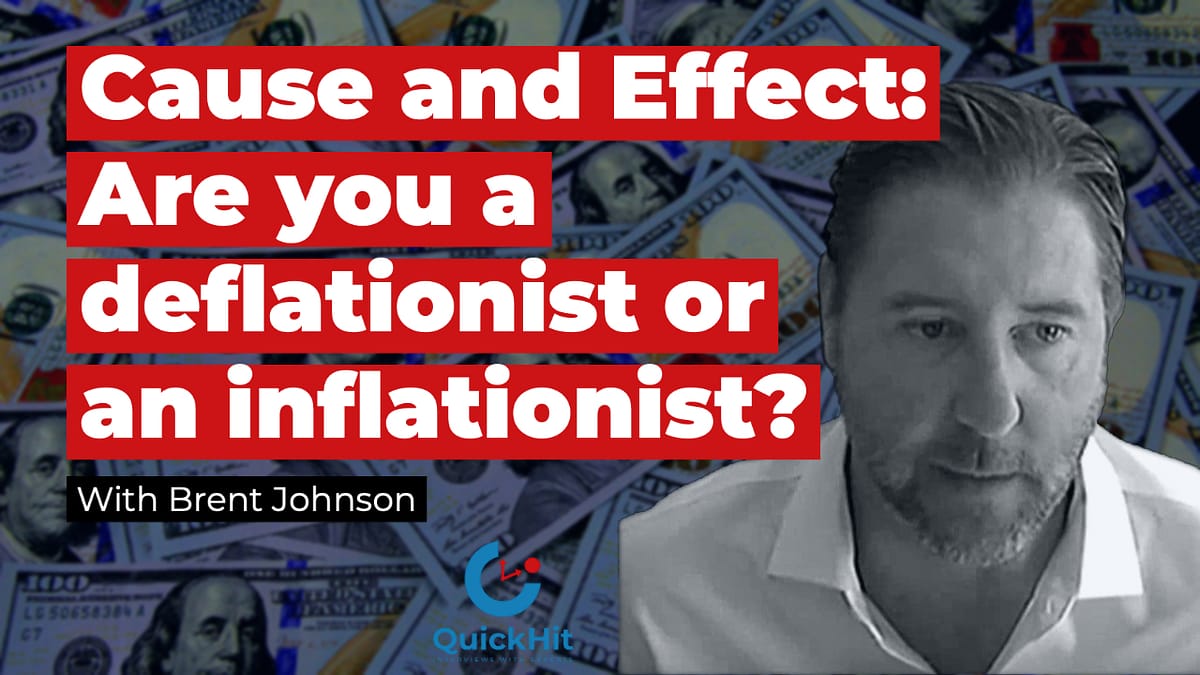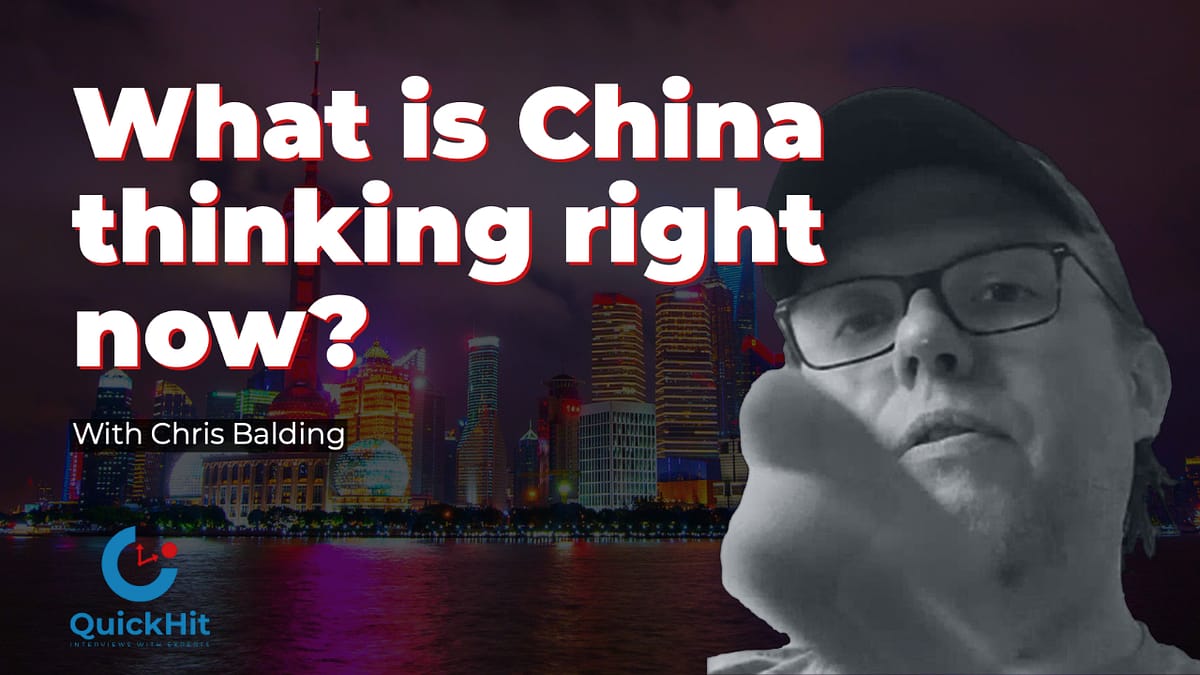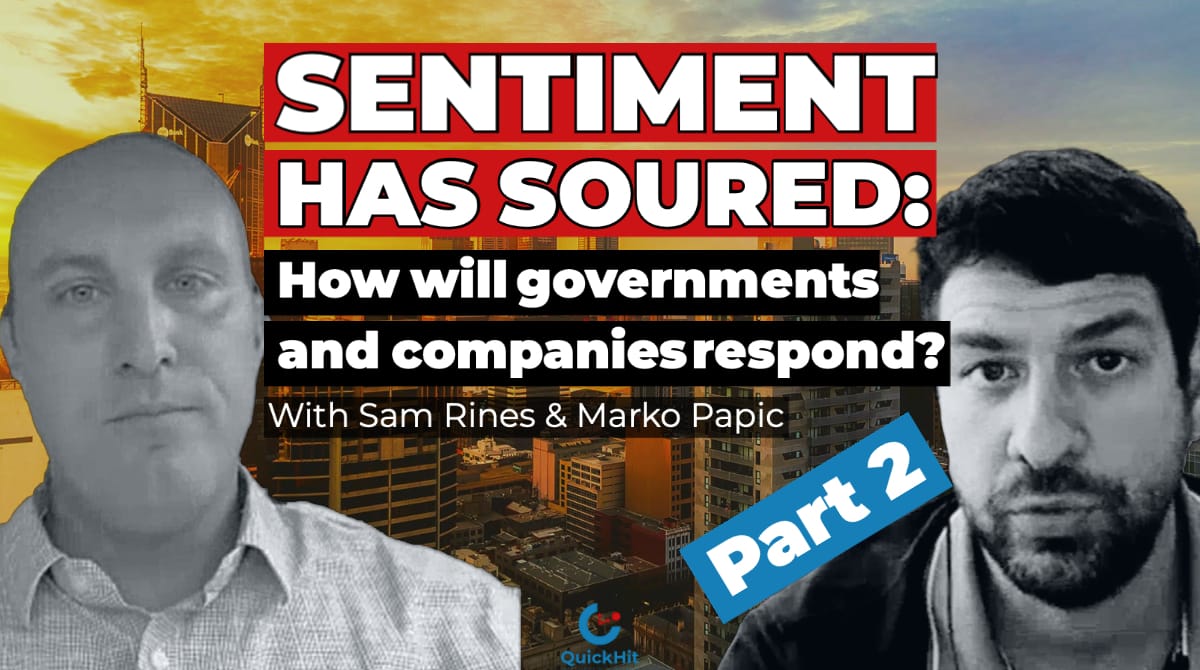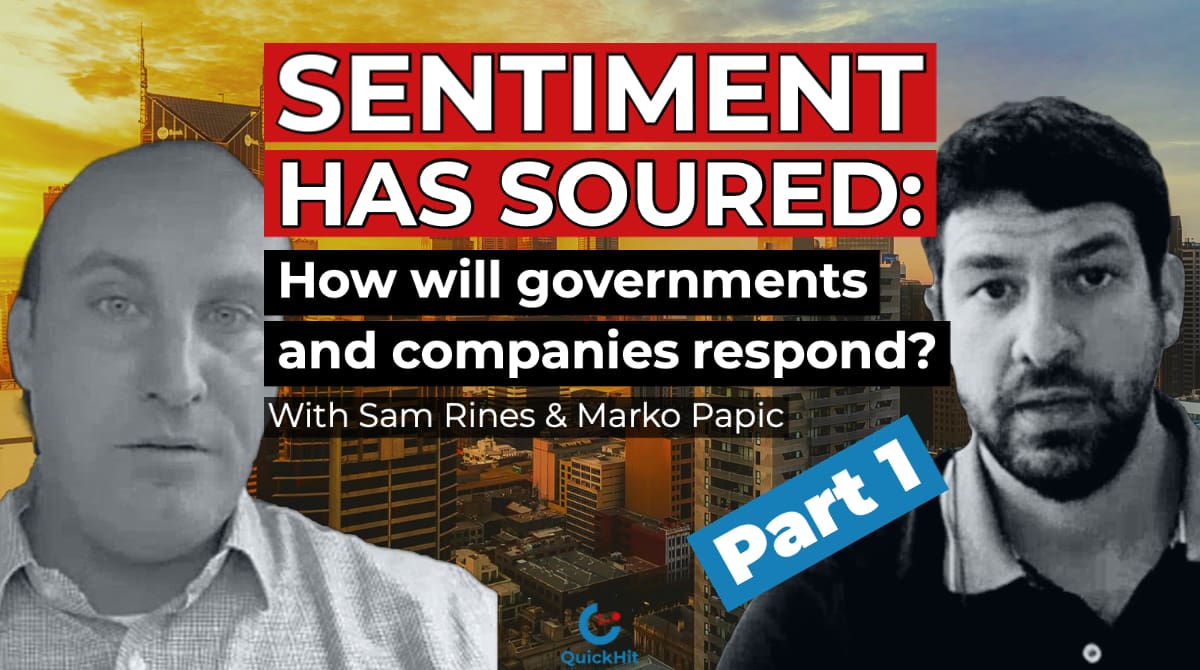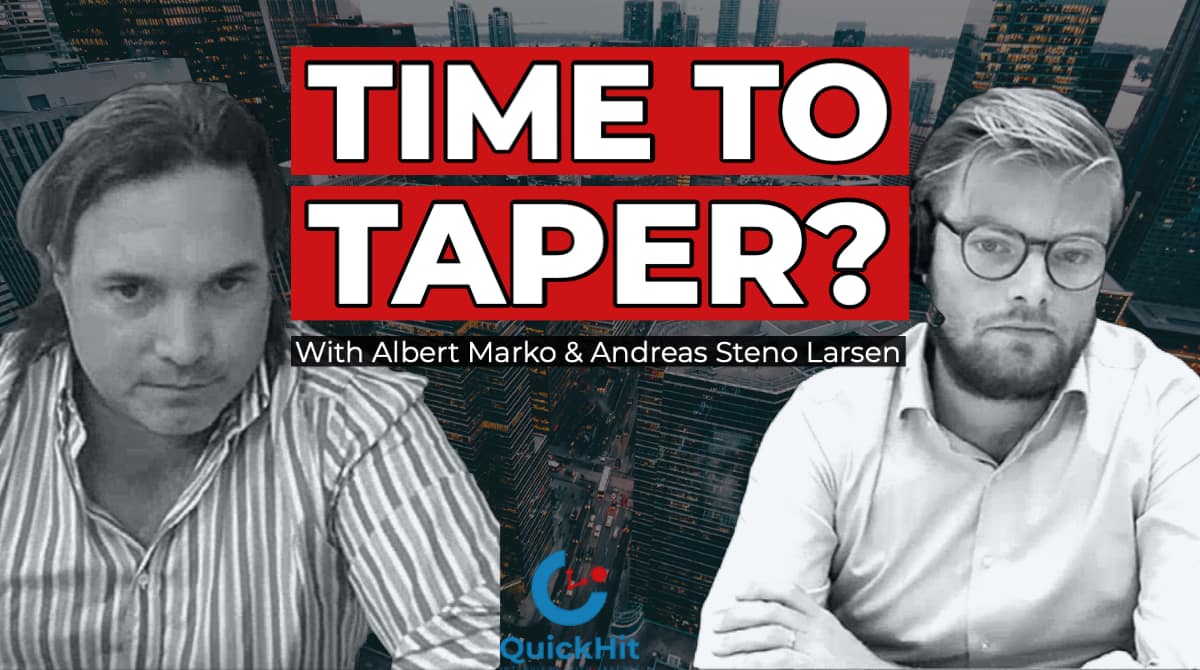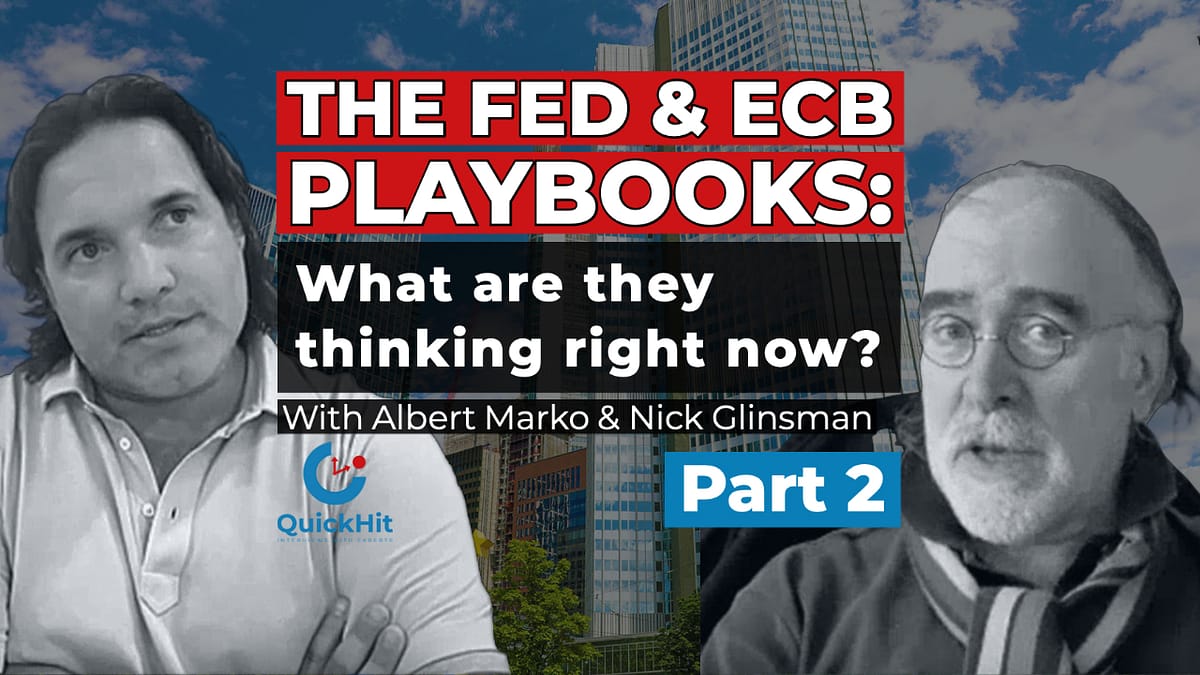This QuickHit episode is joined by central bank and monetary policy expert Brent Johnson. He talks about inflationists versus deflationists and what makes these camps different in a time of a pandemic. What’s monetary velocity? And why banks are failing at their job, and why they’re not lending anymore money? Also discussed China and when supply chain issues will be resolved.
Brent Johnson is the CEO and founder of Santiago Capital, a wealth management firm. He works with about a dozen different families and individuals customizing wealth management solutions for them. He does that through a combination of separately managed accounts and private funds, also invest in outside deals, private deals, venture capital funds, and others. Brent have a focus on macro and loves the big picture.
Subscribe to our Youtube Channel.
💌 Subscribe to CI Newsletter and gain AI-driven intelligence.
📊 Forward-looking companies become more profitable with Complete Intelligence. The only fully automated and globally integrated AI platform for smarter cost and revenue planning. Book a demo here.
📈 Check out the CI Futures platform to forecast currencies, commodities, and equity indices
This QuickHit episode was recorded on September 28, 2021.
The views and opinions expressed in this Cause and Effect: Are you a deflationist or an inflationist? QuickHit episode are those of the guest and do not necessarily reflect the official policy or position of Complete Intelligence. Any contents provided by our guest are of their opinion and are not intended to malign any political party, religion, ethnic group, club, organization, company, individual or anyone or anything.
Show Notes
TN: Part of the reason we’re having this discussion. And is you posted something on Twitter a few weeks ago and I’m going to quote it and we’re going to put it up on screen. You said if you believe an additional QE is on the way, you are secretly a deflationist. If you believe in the taper, you are secretly in the inflation camp. Cause and effect. And I thought it was super interesting. Can you kind of talk through that with us and help us understand what you mean by that?

BJ: Sure. And before I get into that, I’m just going to take a step back because a lot of work I’ve done, a lot of the work I’ve done publicly and put out publicly over the last 10 to 12 years has really been about the design of the monetary system, how it works, how fund flows, you know, this currency versus that currency, what central banks do, etc. Etc.
And this is really a follow on from that and what I was, the point I was trying to get across in this particular tweet is that central banks are a reactive agency. They are not the cause. They are the effect. Now their policies can cause things to happen, but they are reacting to what they see in the market.
And so my point was if you think more QE is coming, then you believe they are going to be reacting to the deflationary forces that still exist in the economy. And so if they were to step back and do nothing, you would have massive deflation.
Now, the flip side of that is if you think that they’re going to taper and you think they’re going to pull away stimulus, then you’re actually an inflationist because you believe inflation is here, it’s going to remain. Prices are going to continue to rise. And the Fed is going to have to step back in reaction to those steadily higher prices.
And so I really get this across because I think there’s a huge battle between the people who believe deflation is next and the people who believe inflation is next. And I think it’s a fantastic debate because I’m not certain which one to come. I kind of get labeled into the deflationary camp, which I don’t mind for a few reasons. But I actually understand all the reasons that the inflationary arguments are being made. And I believe it was a few additional things happen. Then we could get into this sustained inflation. But until those things happen, I’m happy to be labeled into the deflationary camp. So I hope that makes sense.
TN: Yeah. So pull this apart for me. Inflation is ever and always a monetary function. Right. We hear that all the time. Of course, it’s hard to say something “always” is. But people love to quote that. And I think they misapply it in many cases. And I’ve seen that you’ve kind of pushed back on some people in some cases. So can you talk us through that and is this time different? Like, what are the considerations around inflation this time?
BJ: Yeah. So is this a perfect way to set this up because again, I understand the argument that those in the inflationary camp are making. And it would be hard to sit here and say we haven’t seen inflationary effects for the last twelve months. Prices have risen. Regardless of why or whatever prices have gone up. So I’m not going to sit here and deny that we’ve had inflationary pressures.
The question is what comes next. And I think what I would say with regard to the quote that you were just making, I think that was, I can’t remember who said it now, but it’s 50 or 60 years ago. And what I think was assumed in that quote was that monetary velocity is constant. And so you’ve seen these huge rises in the monetary base. But not just the United States, but Canada, Europe, South America, China and Japan.
And so the thought is that with that new money in the system, you’re naturally going to have inflation. But I think Lacy Hunt, who a fellow Texan of yours, does a fantastic job of showing, had the rate of monetary velocity stay the same. That is absolutely the case. But the reality is monetary velocity kind of took a nose dive starting about 20 years ago, and it just continued to lower and lower and lower.
TN: And it’s been negative, right, for the past couple years?
BJ: Yeah. It just continues to fall. And I think the rule is…
TN: Let me just stop you right there. “Negative velocity of money.” What does that mean?
BJ: What it essentially means is that new credit is not being created. And so the system is contracting. And this is really the key to it all. It’s the key to the way the monetary system is designed. It’s the key to the way it functions. And it’s the key to whether we’re going to have inflation or deflation next.
Because I do agree with the money, the inflation is always and everywhere, a monetary phenomenon, assuming that velocity is constant. But velocity isn’t constant. And it’s because of the way the monetary system is designed. And it’s because of the way that the Fed and other central banks have been providing stimulus.
Probably don’t have time to get into all the details of what a bank reserve is and whether it is or whether it isn’t money. But essentially what the central banks have been doing, especially the Fed, is re collateralizing the system. Now re collateralizing the system isn’t exactly the same thing as actually handing somebody else physical money. It sort of is, but it sort of isn’t. And it leads to this big debate on whether they’re actually printing money or not. It’s my argument that the Fed has been re collateralized the system and that has kept prices from continue to fall.
But in order to get this sustained inflation, I keep saying sustained inflation because I don’t want to deny, but we’ve had it. But to have it continue going higher, especially at the rate we’ve seen would require one of two things. Either the Congress has to come out and agree to spend another seven or $8 trillion, which this week is showing, it’s very hard to get them to agree to do that. They can’t even agree on 3.5 trillion and let alone another 6 to 7. Or the banks have to start lending. And the banks simply are not lending.
They lent last year because the loans that the banks made were guaranteed by the government. These were the PPP loans that everybody got.
TN: So. What you’re saying, it sounds to me, and correct me, what you’re essentially saying is that banks are failing as a transmission mechanism. So the government has had to become the transmission mechanism because banks aren’t doing what their job should be. Is that true?
BJ: That’s a very good way of putting it.
TN: Why? Why are banks not the transmission mechanism that they should be?
BJ: Well, they have the potential to be. And that’s what I say. The Fed has provided the banks all the kindling for lack of a better word, all the starter fuel to create this inflationary storm. But the banks haven’t done it. I would argue. Now there’s people to disagree with me. But I would argue that they don’t want to make a loan because believe it or not, banks don’t want to rely on getting bailed out, and they don’t want to make a loan where they are not going to get their money back.
Now, if you’re in an environment where businesses have been shut down either because of the pandemic or because of other laws or because of regulations that can’t afford all the regulations, whatever it is, you know, it’s hard to loan somebody a million dollars if you don’t know that their business is even going to be open the next day. Right.
So banks aren’t in the business of going out and making a loan and having and default on them. They want to get their money back. And I think that they would rather go out and buy a treasury bond that’s yielded one and a half percentage, than make a loan that pays them, three or four of them might go bad. Right.
TN: Okay.
BJ: So to me, that’s indicative of the deflationary forces that the banks who are closer to the money than anybody else, and typically the people that are close to money understand the money or benefit from the money the most, they are telling me from by their actions, maybe not their words, but their actions are telling me they don’t think this is a great investment.
TN: Yeah. I think we could talk about that point for, like, 20 minutes. So let’s switch to something else. So what you didn’t really mention is the supply side of the market in terms of inflation, meaning supply chain issues, these sorts of things. Right.
And so I want to focus a little bit on China. Now, there’s a lot happening in China, and I want to understand how that impacts your worldview.
In China, we’ve got the crypto regulation that’s come in. And the clampdown in crypto. We have a strong CNY, like an unusually strong CNY over the last six or nine months. We have the power supply issues. We have the supply chain issues. That’s a lot happening all at one time, at a time when a lot of people believe there’s kind of China has this clear path to ascendency, but I think they have a lot of headwinds, right. Of those kind of how are you thinking about those factors? The crypto factor, the supply chain factor, the power factor? How are you thinking about that stuff?
BJ: So I think about this a lot first of all. I mean, this is a probably, like it or not, for better force, the China-United States dynamic is probably one of the biggest macro drivers for the next ten or 20 years. It most likely will be. There’s nothing is guaranteed. But that’s probably a pretty safe bet that that’s going to be one of the main drivers. And so I think what you’re touching on as far as the supply chain, in my opinion, that is as big a driver as the “money printing” for the inflationary effects that we’ve seen for the last year.
You know, if you look at the efficiency with which the single global supply chain that Xi call it from 1990 to 2018 or 19, it’s pretty amazing, right. There’s one global supply chain, just in time inventory, you can predict with a very high level of certainty when you would get those things you ordered and at what price. But then with a combination of the US and Chinese antagonism and COVID, the supply chains are broke. And that makes it harder to get those supplies. And the timing of when you get them in the price, which you get to miss completely unknown or its delay, and the prices are higher.
And so I think that has led to a lot of the price pressure on commodities. Now, part of the reason that the decreasing supply push prices up was that demand stayed flat or went up it a little bit. And I think the reason it went up is a lot of people believe that the Fed would print enough money to cause demand to stay, solid and that China was growing and that they would continue. China has been the growth driver for the global economy for years and years. And I think a lot of people thought that China would continue to be that growth driver for these commodities and these other goods that were needed. And so if demand stays flat arise and supply gets cut, then price rises.
Now, I don’t think that China growing and ascending to economic hegemony or however you want to describe it is a given. I think they have more troubles internally than they would like to admit. And I think we’re starting to see that, with the Evergrande, real estate daisy chain of credit extension. You know, if you think that the US has a credit problem, take a look at China, they do as well. And it’s manifested itself nowhere more visibly than in the real estate market there and Evergrande.
Now, the problem is if they cannot send that credit contraction that is currently taking place in the Chinese market from a real estate perspective, then demand is not going to stay cloud. Demand is must start to fall, and demand starts to fall and some of those supply chain logistics start to get ironed out. Now, they’re not going to get fixed overnight. It’s not going to go back to the way it was 18 months ago. But if it even gets a little bit better and demand starts to fall, well, then you could have a move down in commodity prices and then move down in growth expectations.
And that is the way deflationary pressures could take whole. And as those prices start to come down, then you get more credit contraction. It becomes a vicious cycle both to the upside and to the downside. But based on the design of the monetary and I don’t need to keep harping on this. But based on the design of the monetary system, it is literally the stair step up in the elevator shut down. That’s just the way it’s designed. It’s an inherently inflationary system that it has to grow. Or if it doesn’t grow, then it crashes. And crash has always happened faster and steeper than the stairstep higher.
TN: They take longer, but steeper on the way up. Right.
BJ: That’s right. That’s right.
TN: Okay. So in terms of the supply chain issues, okay. I’m just curious, is this something that you think is going to resolve itself in three or six months? Do you think it’s something that’s with us for three years or what was I feeling out of this?
BJ: Some of it is gonna resolve itself in three or six months? And I think that will be a combination of just working out the kinks and demand falling. Right. I think that will help. But I don’t think it’s all going to get fixed in three to six months, and I think it might take three to six years to get the other part of it. And this is where I have to actually say that in the past, I’ve been somewhat critical of the people who called for stagflation because I kind of felt the top out, right? You couldn’t decide. So you just go down the middle.
But I actually think that that’s a very likely scenario. I think some things are going to inflate and some things are going to deflate and we’re going to have this kind of the stagflationary environment. I think the central banks are going to do everything they can to kind of offset those deflationary pressures. And in some cases, it will work. In some cases, they won’t. But the global debt, the amount of global debt and the global dollar… Is so big that deflationary scare, in my opinion, is always going to be there. And in my opinion, you can’t ignore it.
A lot of people just think, oh, don’t worry about it. Central banks, have you back. There’s a Fed put, don’t need to worry about it. I understand that argument, but I don’t think it’s correct. I think you do have to worry about it.
TN: Yes, I think that’s right. Brent, I would love to talk to you for another couple of hours. I think we could do it. And I’d love to revisit this in a few months. Thank you so much for your time for everyone watching. If you wouldn’t mind following us on YouTube and subscribing, we’d really appreciate that. That helps us get up to where we can promote more and other things. And, Brent, I really appreciate your time and really appreciate this conversation. Thank you very much.

